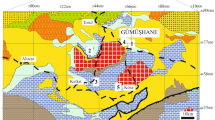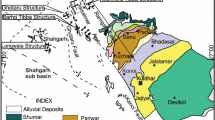Abstract
Among several lithostratigraphic subdivisions of the Gaj Formation of Miocene age, the Jhill limestone is entirely different with respect to its colour, texture and structures. This limestone unit has been evaluated to elaborate its geochemical and sedimentological characteristics. The distribution of various elements in the acid-soluble fraction has been studied in order to determine their mineralogy, sedimentary environment, facies and diagenesis. Mineralogy, recrystallization and other diagenetic changes are the main factors affecting the distribution of trace elements and their mutual relationships in the limestones. Samples of the Jhill limestone show depletion in large-sized ions (Sr, Pb & K) and also in the ions that are not compatible with calcite space group. Elements (Fe, Mn, Zn, Cu & Co) having distribution coefficient (D) above unity for natural calcites, are more enriched. Microscopic and X-ray studies revealed nearly complete conversion of aragonite into stable low-Mg calcite.
An attempt has also been made to verify the reefal conditions for these limestones on the basis of geochemical studies. The plots of Sr and other facies-indicator elements show that the majority of the beds belong to forereef flank facies with some algal banks. Low Mg/Ca and Sr/Ca ratios suggest that a phreatic diagenetic environment prevailed after the deposition. High concentrations of Cr, Ni, and Co in the Jhill limestone show a positive correlation with a higher amount of insoluble residue, which reflects a relatively high rate of influx of terrigenous material.
Similar content being viewed by others
References
Ahmed, W., A.M. Subhani, and S.S.H. Abidi, 1983, Geological map of Karachi: Geol. Surv. Pakistan, Quetta.
Al-Qayim, B., 1989, Diagenetic model of a reef complex, Aqra-Bekhme Formation (Late Cretaceous) northeastern Iraq: Acta Mineralogica-Petrographica, v. 30, p. 149–159.
Balson, P.S., 1983, Temperate, meteoric diagenesis of Pliocene skeletal carbonates from eastern England: Journal of the Geological Society London, v. 140, part 3, p. 377–385.
Baker, P.A., J.M. Gieskes, and H. Elderfield, 1982, Diagenesis of carbonates in deep-sea sediments: Evidence from Sr/Ca ratios and interstitial dissolved Sr data: Jour. Sed. Petrology, v. 52, p. 70–82.
Boer, R.B., 1977, Stability of Mg-Ca carbonates: Geochimica et Cosmochimica Acta, v. 41, p. 265–270.
Bosence, D.W.J., 1983, Coralline algal reef frameworks: Journal of the Geological Society, London, v. 140, part 3, p. 365–376.
Chester, R., 1965, Geochemical criteria for differentiating reef from nonreef facies in carbonate rocks: Bull. Am. Asso. Petro. Geol. v. 49, p. 258–276.
Chilingar, G. V., H.J. Bissell, and K.H. Wolf, 1979, Diagenesis of carbonate sediments and epigenesis (or catagenesis) of limestones, in developments in sedimentology, in G. Larsen and G. V. Chilingar, eds., Diagenesis in sediments and sedimentary rocks, Elsevier, v.25a, p. 247–422.
Clark, D. N. et al., 1984, Carbonate Geology: A course organised by the Open University Department of Earth Sciences, p. 170.
De Wet, C.B., 1987, Deposition and diagenesis in an extensional basin: the Corallian Formation (Jurassic) near Oxford, England, in J.D. Marshall, ed., Geological Society Special Publication; Blackwell Scientific Publications, n. 36, p. 339–353.
Dickson, T., 1990, Carbonate mineralogy and chemistry, in M. E. Tucker and V. P. Wright, eds., Carbonate sedimentology: Blackweel Sci. Pub. Oxford, p. 482.
Emery, D., 1987, Trace-element source and mobility during limestone burial diagenesis—an example from the Middle Jurassic of eastern England: Diagenesis of sedimentary sequences, p. 201–217.
Farshori, M.Z., 1972, The geology of Sind: Dept. of Geology, University of Sind, p. 81 (unpublished).
Folk, R.L., 1959, Practical petrographic classification of limestones: Bull. Am. Asso. Petrol. Geol. v. 43, p. 1–38.
Folk, R.L. and L.S. Land, 1975, Mg/Ca ratio and salinity, two controls over crystallization of dolomite: Bull. Am. Asso. Petrol. Geol., v. 59, p. 60–68.
Gawad, M.A., 1971, Wrench movements in the Baluchistan arc and relation to Himalayan-Indian Ocean tectonics: Geol. Soc. Amer. Bull. v. 82, p. 1235–1250.
Goldsmith, J.R., 1959, Some aspects of the geochemistry of carbonates, in P. H. Abelson, ed., Researches in geochemistry: New York, John Wiley & Sons, p. 336–358.
Graf, D.L., 1960, Geochemistry of carbonate sediments and sedimentary carbonate rocks, Part III, Minor element distribution: Illinois State Geol. Surv. Urbana, p. 71.
Hasnain, S.M., M.A. Farooqi, and M.J. Muhammad, 1987, Lithostratigraphy and microfauna of Cape Monze area, Karachi: Kar. Uni. Jour. Sci. v. 15, Nos. 1 & 2, p. 13–22.
Hunting Survey Corp., 1960, Reconnaissance geology of part of West Pakistan, A Colombo Plan-Cooperative Project, Toronto, Canada, 550p.
Iqbal, M.W. A., 1980, Oligo-Miocene bivalves and gastropods from Kirthar Province, Lower Indus Basin, Pakistan: Geol. Sur. Pak. Quetta, Records of Geol. Sur. Pak. v. 51, p. 59.
Ireland, H.A., 1949, Insoluble residue, in Subsurface geologic methods, in L.W. LeRoy, ed., Symposium Colorado School of Mines, p. 140–156.
James, N.P. and C.F. Klappa, 1983, Petrogenesis of Early Cambrian reef limestone, Labrador, Canada: Jour. Sedi. Petrology, v. 53, p. 1051–1096.
Katz, A., Sass, A. Starinsky, & H.D. Holland, 1972, Strontium behavior in the aragonite-calcite transformation: An experimental study at 40 –98°C: Geochimica et Cosmochimica Acta, v. 36, p. 481–496.
Keith, M.L. and E.T. Degens, 1959, Geochemical indicators of marine and fresh-water sediments, in P.H. Abelson, ed., Researches in geochemistry: New York, John Wiley & Sons, p. 38–61.
Khan, M. H., 1968, The dating and correlation of the Nari and the Gaj Formations: The Geol. Bull, of the Punjab Uni., n.7, p. 57–65.
Khan, R.A., 1973, Geological investigation of the area between Gadani and Cape Monze: Geol. Sur. Pak. Quetta, I.R., n.66, p. 37.
Longman, M.W., 1982, Carbonate diagenesis as a control on stratigraphic traps, in AAPG Fall, ed., Conf. Calgary, Canada, Course, n.21, p. 159.
Lowenstam, H.A. & S. Weiner, 1983, Mineralization by organism and the evolution of biomineralization, in P. Westbroek & E.W. Dejong, eds., Biomineralization and biological metal accumulation: Reidel Pub. Co. Dordrecht, p. 191–203.
MacGregor, A. R., 1983, The Waitakere limestone, a temperate algal carbonate in the lower Tertiary of New Zealand: Jour. Geol. Soc. London, v. 140, part 3, p. 387–399.
Mallick, K. A. and B. J. Al-Qayem, 1985, Sedimentology of Sinjar Limestone Formation, Sulaimanian area, northeastern Iraq: Acta Mineralogica-Petrographica, Szeged, v. 27, p. 101–116.
Nair, K.M. and M. Azmatullah, 1981, Significance of strontium distribution in limestones: Jour. Min. Geol., v. 18, p. 114–119.
Okumura, M. and Y. Kitano, 1986, Coprecipitation of alkali metal ions with calcium carbonate: Geochim. et Cosmochim. Acta, v. 50, p. 49–58.
Pingitore, N.E., 1978, The behavior of Zn and Mn during carbonate diagenesis: Theory and application: Jour. Sed. Petrology, v. 48, p. 799–814.
Pingitore, N.E., 1982, The role of diffusion during carbonate diagenesis: Jour. Sed. Petrology, v. 52, p. 27–39.
Shah, S.M.I., 1977, Stratigraphy of Pakistan, in Mem., ed., Geol. Survey of Pakistan, Quetta: v. 12, p. 138.
Stenberg, T.E., A.G. Fischer, and H.D. Holland, 1959, Strontium content of calcites from the Steinplatte reef complex, Austria: Bull. Geol. Soc. Am. v. 70, p. 1681.
Tucker, M., 1990, Modern carbonate environments, in M.E. Tucker, V.P. Wright & J. A.D. Dickson, eds., Carbonate sedimentology: Oxford, Blackwell Sci. Pub., p. 70–100.
Turekian, K.K. and K.H. Wedepohl, 1961, Distribution of the elements in some major units of the earth’s crust: Geol. Soc. America Bull., v. 72, p. 175–192.
Xun, Z, and I.J. Fairchild, 1987, Mixing zone dolomitization of Devonian carbonates, Guangxi, South China, in J.D. Marshall, ed., Geological Society Special Publication: Blackwell Sci. Pub., n.36, p. 157–170.
Author information
Authors and Affiliations
Rights and permissions
About this article
Cite this article
Naseem, S., Sheikh, S.A. & Qadeeruddin, M. Geochemistry and sedimentology of Jhill limestone of Gaj formation, in Cape Monze and adjoining area, Karachi. Chin. J. of Geochem. 15, 213–227 (1996). https://doi.org/10.1007/BF02842246
Issue Date:
DOI: https://doi.org/10.1007/BF02842246




